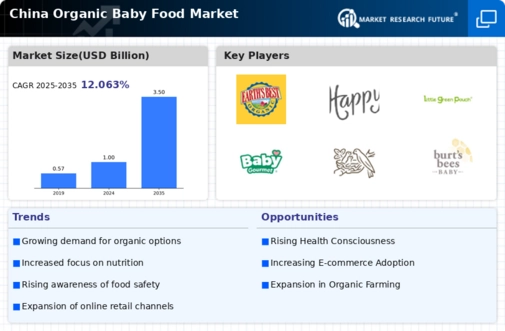Rising Disposable Income
In recent years, the organic baby-food market in China has been positively influenced by the rising disposable income of households. As families experience an increase in their financial capacity, they are more willing to invest in premium products, including organic baby food. Market data suggests that the organic baby-food market has seen a growth rate of approximately 15% annually, correlating with the upward trend in disposable income. This economic shift allows parents to prioritize quality over cost, leading to a greater demand for organic options that promise better nutrition and safety for their children.
Concerns Over Food Safety
Concerns regarding food safety are a driving force behind the growth of the organic baby-food market in China. Recent food safety scandals have heightened parental awareness about the quality of food products available in the market. As a result, many parents are opting for organic baby food, which is perceived to be safer and free from harmful additives. The organic baby-food market is thus positioned to capitalize on this trend, as parents seek assurance that the food they provide to their children meets stringent safety standards. This shift towards organic options is likely to continue as consumers demand greater transparency and accountability from food manufacturers.
Increasing Health Consciousness
The organic baby-food market in China is experiencing a notable surge in demand driven by a growing awareness of health and nutrition among parents. As more families prioritize the well-being of their children, the preference for organic products has intensified. Recent surveys indicate that approximately 70% of parents in urban areas are inclined to choose organic baby food over conventional options, reflecting a shift towards healthier dietary choices. This trend is further supported by the increasing availability of organic products in retail outlets, which enhances consumer access. The organic baby-food market is thus poised for growth as health-conscious parents seek products that align with their values of nutrition and safety.
Government Support for Organic Farming
The organic baby-food market in China benefits significantly from government initiatives aimed at promoting organic agriculture. Policies that support organic farming practices, including subsidies and training programs for farmers, have been implemented to enhance the quality and quantity of organic produce. As a result, the organic baby-food market is witnessing an increase in the supply of locally sourced organic ingredients, which not only supports local economies but also reduces transportation costs. This alignment with government objectives is likely to foster consumer trust and encourage the adoption of organic baby food among parents, further driving market growth.
Influence of Social Media and Online Marketing
The organic baby-food market in China is increasingly shaped by the influence of social media and online marketing strategies. Parents are turning to digital platforms for information and recommendations regarding baby food options. Influencers and parenting blogs play a crucial role in shaping consumer perceptions and preferences, often highlighting the benefits of organic products. The organic baby-food market is leveraging these platforms to reach a broader audience, with online sales channels experiencing significant growth. This digital engagement not only enhances brand visibility but also fosters a community of health-conscious parents who share their experiences and recommendations.
























Leave a Comment